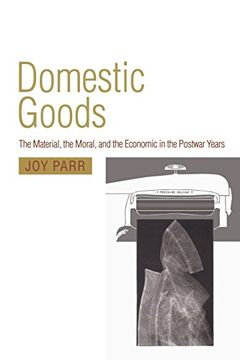Compartir
Domestic Goods: The Material, the Moral and the Economic in the Postwar Years (Hsbc Bank Canada Papers on Asia) (en Inglés)
Joy Parr (Autor)
·
· Tapa Blanda
Domestic Goods: The Material, the Moral and the Economic in the Postwar Years (Hsbc Bank Canada Papers on Asia) (en Inglés) - Joy Parr
$ 13.630
$ 18.930
Ahorras: $ 5.300
Elige la lista en la que quieres agregar tu producto o crea una nueva lista
✓ Producto agregado correctamente a la lista de deseos.
Ir a Mis Listas
Origen: Estados Unidos
(Costos de importación incluídos en el precio)
Se enviará desde nuestra bodega entre el
Lunes 29 de Julio y el
Lunes 05 de Agosto.
Lo recibirás en cualquier lugar de Chile entre 1 y 3 días hábiles luego del envío.
Reseña del libro "Domestic Goods: The Material, the Moral and the Economic in the Postwar Years (Hsbc Bank Canada Papers on Asia) (en Inglés)"
Visions of life in the 1950s often spring from the United States: supermarkets, freeways, huge gleaming cars, bright new appliances, automated households. Historian Joy Parr looks beyond the generalizations about the indulgence of this era to find a specifically Canadian consumer culture. Focusing on the records left by consumer groups and manufacturers, and relying on interviews and letters from many Canadian women who had set up household in the decade after the war, she reveals exactly how and why Canadian homemakers distinguished themselves from the consumer frenzy of their southern neighbours. Domestic Goods focuses primarily on the design, production, promotion, and consumption of furniture and appliances. For Parr, such a focus demands an analysis of the intertwining of the political, economic, and aesthetic. Parr examines how the shortage of appliances in the early postwar years was a direct result of government reconstruction policy, and how the international style of 'high modernism' reflected the postwar dream of free trade. But while manufacturers devised new plans for the consumer, depression-era frugality and a conscious setting of priorities within the family led potential customers to evade and rework what was offered them, eventually influencing the kinds of goods created. This book addresses questions such as, who designed furniture and appliances, and how were these designs arrived at? What was the role of consumer groups in influencing manufacturers and government policy? Why did women prefer their old wringer washers for over a decade after the automatic washer was brought in? In finding the answers the author celebrates and ultimately suggests reclaiming a particularly Canadian way of consuming.
- 0% (0)
- 0% (0)
- 0% (0)
- 0% (0)
- 0% (0)
Todos los libros de nuestro catálogo son Originales.
El libro está escrito en Inglés.
La encuadernación de esta edición es Tapa Blanda.
✓ Producto agregado correctamente al carro, Ir a Pagar.

